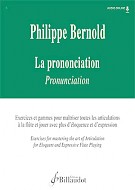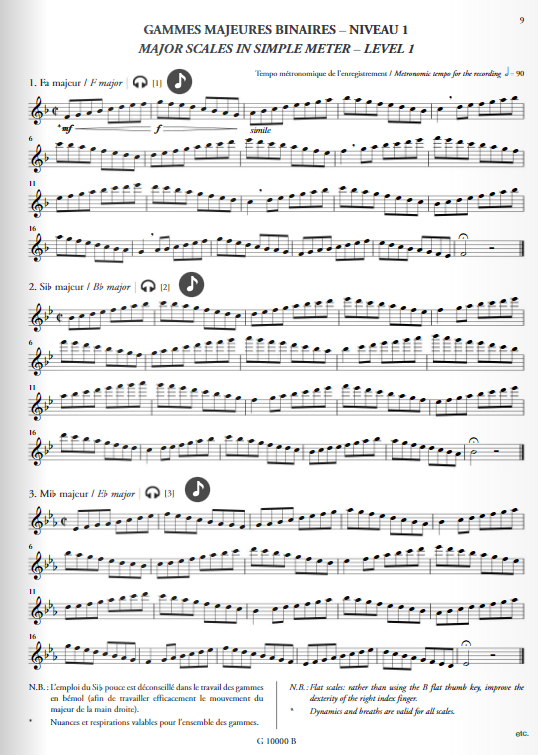
Happy Present Meet

Bernold La prononciation for Flute Solo
Bernold La prononciation - Exercices et gammes pour maîtriser toutes les articulations à la flûte et jouer avec plus d’éloquence et d’expression for Flute
Exercises and scales to master all the articulations on the flute and play with more eloquence and expression
플루트의 모든 관절을 마스터하고 더욱 웅변적이고 표현력 있게 연주할 수 있는 연습 및 음계
Studies - Flute
Instrumentation: Supports audio en ligne
L’articulation – la prononciation – est un élément fondamental dans le jeu de la flûte.
Sa maîtrise nous permet d’avoir un discours clair, varié, coloré et donc vivant. L’articulation à la flûte traversière se fait en coupant le son avec la langue, comme un chanteur coupe une ligne mélodique avec des mots. Ce cahier a pour vocation d’approfondir ces nombreuses possibilités d’expression en s’appuyant sur deux séries de gammes majeures et mineures, mais également en abordant de nombreux exercices et traits d’orchestre.
L’ouvrage est divisé en six chapitres :
- Le premier chapitre traite de la connexion entre le souffle, la langue et les doigts sur des gammes binaires majeures et mineures et sur des gammes ternaires majeures à l’ambitus réduit (gammes
niveau 1) ;
- Le deuxième chapitre est centré sur la place de la langue. Au travers d’exercices souvent tirés du répertoire, c’est l’étude du détaché « français » qui est abordé ici ;
- Le troisième chapitre explore l’ensemble des articulations sur une nouvelle série de gammes binaires majeures et mineures (niveau 2) à l’ambitus plus grand ;
- Le quatrième chapitre est destiné à améliorer la vitesse du double et triple coup de langue
- Le cinquième chapitre traite des différents modes d’attaque des sons ;
- Le sixième chapitre présente les principaux traits d’orchestre, ainsi qu’une étude complémentaire où l’articulation est la difficulté principale.
On trouvera à la fin du volume un chapitre intitulé « Notes pour les curieux ! » constitué d’articles d’approfondissement ainsi qu’un paragraphe sur l’articulation au travers des méthodes d’enseignement du XVIIe au XXe siècles.
Les accompagnements audio mentionnés dans cet ouvrage sont disponibles sur notre Espace éducation : www.edu.billaudot.com/gb10000
Articulation, pronunciation, is a fundamental element in playing the flute. Its mastery allows us to have a clear, varied, colorful and therefore lively speech. Articulation on the transverse flute is done by cutting the sound with the tongue, like a singer cutting a melodic line with words. This notebook aims to deepen these numerous possibilities of expression by relying on two series of major and minor scales, but also by tackling numerous exercises and orchestral features. The work is divided into six chapters: — The first chapter deals with the connection between the breath, the tongue and the fingers on major and minor binary scales and on major ternary scales with reduced ambitus (scales level 1); — The second chapter focuses on the place of language. Through exercises often taken from the repertoire, it is the study of the “French” detached which is approached here;— The third chapter explores all the articulations on a new series of major and minor binary scales (level 2) at greater ambitus; — The fourth chapter is intended to improve the speed of the double and triple lick - the fifth chapter deals with the different modes of attack of sounds; — The sixth chapter presents the main orchestral features, as well as a complementary study where articulation is the main difficulty. At the end of the volume there is a chapter entitled “Notes for the curious!” » consisting of in-depth articles as well as a paragraph on the articulation through teaching methods from the 17th to the 20th century.
조음, 발음은 플루트 연주의 기본 요소입니다. 그것의 숙달로 인해 우리는 명확하고 다양하며 다채롭고 생생한 연설을 할 수 있습니다. 가로 플루트의 조음은 마치 가수가 가사로 멜로디 라인을 자르는 것처럼 혀로 소리를 자르는 방식으로 이루어집니다. 이 노트는 두 가지 시리즈의 장음계와 단음계를 사용하고 수많은 연습과 오케스트라 기능을 다루면서 이러한 다양한 표현 가능성을 심화시키는 것을 목표로 합니다. 이 작품은 6개 장으로 구성되어 있습니다. — 첫 번째 장은 장조 및 단조 이진 음계와 양각이 감소된 장3항 음계(음계 레벨 1)에서 호흡, 혀 및 손가락 사이의 연결을 다루고 있습니다. — 두 번째 장은 언어의 위치에 초점을 맞춥니다. 종종 레퍼토리에서 가져온 연습을 통해 여기에서 접근하는 것은 "프랑스어" 분리에 대한 연구입니다. - 세 번째 장은 더 큰 범위에서 새로운 일련의 장조 및 단조 이진 음계(레벨 2)의 모든 조음을 탐구합니다. — 네 번째 장은 이중 및 삼중 핥기의 속도를 향상시키기 위한 것입니다. 다섯 번째 장은 다양한 소리 공격 모드를 다룹니다. — 여섯 번째 장은 오케스트라의 주요 특징을 제시하고, 조음이 가장 어려운 부분에 대한 보완적인 연구를 제공합니다. 책의 마지막에는 “호기심 있는 사람들을 위한 참고 사항!”이라는 제목의 장이 있습니다. » 심층적인 기사와 17세기부터 20세기까지의 교육 방법을 통한 표현에 대한 단락으로 구성되어 있습니다.
작곡가 Bernold, Philippe

The Golden Age of The Flutists Vol.1 for Flute and Piano
Bernold La Technique d`Embouchure for Flute Solo
Bernold Le Souffle, Le Son (The Wind, the Sound) for Flute Solo
Bernold La Technique d`Embouchure for Flute Solo
Bernold La Technique d`Embouchure for Flute Solo
Bernold Le Souffle, Le Son (The Wind, the Sound) for Flute Solo
Bernold La Technique d`Embouchure for Flute Solo
Boehm Grande Polonaise Op.16 in D Major for Flute and Piano
[특가상품] Debussy Prelude to 'Afternoon of a Faun' for Flute and Piano
Mercadante 10 Arias Variations sur des Airs D`Operas for Flute Solo